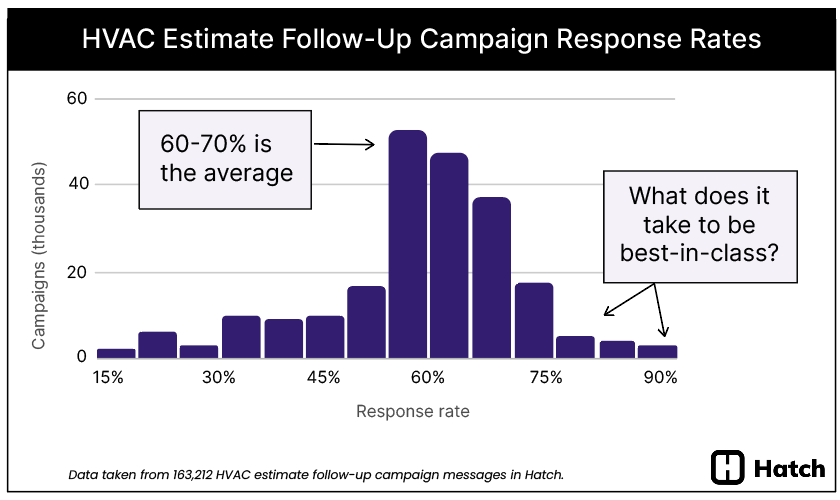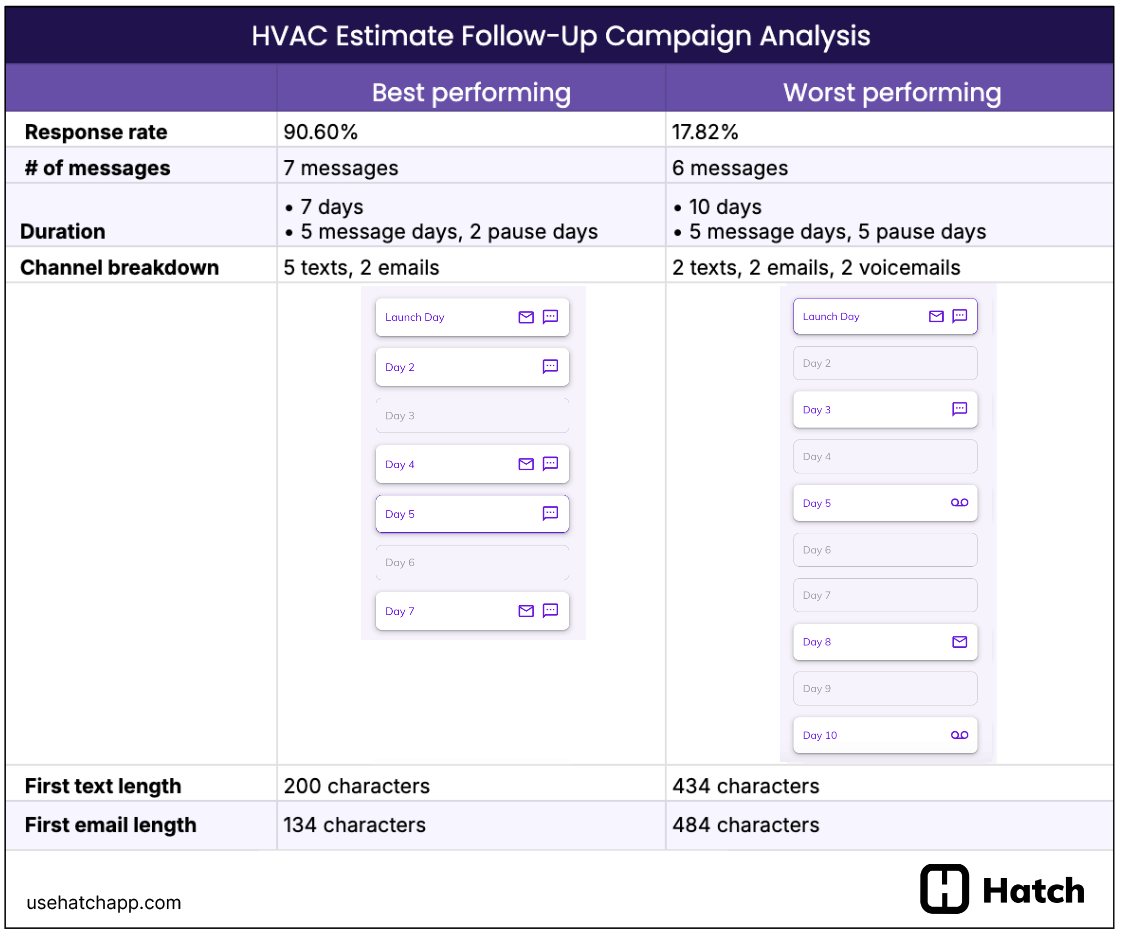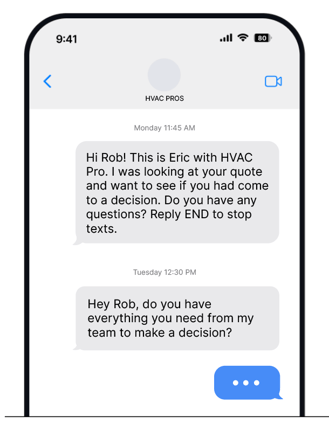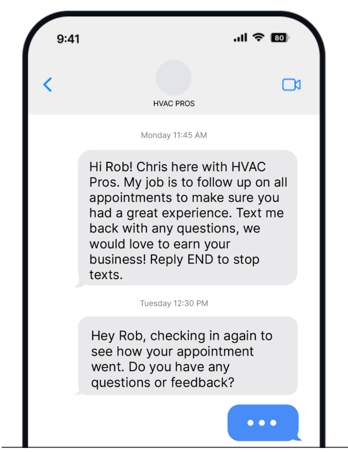Every year, HVAC businesses leave thousands of dollars on the table in unsold estimates, due to none other than lack of follow-up. This is why estimate follow-up campaigns are one of the most popular use cases in Hatch.
But not every campaign performs equally. So, what makes a successful one? We analyzed 163k HVAC estimate follow-up campaigns launched using Hatch to bring you this answer.
This post shares what we found, along with insights from John Wilson, a Hatch customer who is the CEO of The Wilson Companies and the host of the Owned and Operated Podcast.
Let’s dive in.
How we’re defining an HVAC estimate follow-up campaign
The HVAC estimate follow-up campaigns in this study were 2-day follow-ups. So, a technician or sales rep goes out to assess the homeowner's needs. They then provide an estimate. The follow-up campaign in Hatch is then triggered two days after.
All too often, businesses follow up once, maybe twice, on these appointments and estimates—and that is simply not enough. It takes 8-12 touches to close a deal for 80% of deals. In other words, they’re leaving tons of unclosed revenue on the table.

Hatch automates the outreach for this. This is one of the many ways Wilson Plumbing and Heating is using Hatch, and it’s been a success. “We're selling a ton of unsold estimates, and it's easier than ever to book follow-up appointments,” said John. “Hatch has been a really big win for us.”
Average response rate for HVAC estimate follow-up campaigns
The best performing campaign had a response rate of 90.06%. The worst performing campaign had a response rate of 17.82%. The average response rate was 60%.

You may be thinking that if you're in the 60% range, then that's good. Which it is, but good is just...good. Average is just....average.
The most successful businesses are the ones that do everything above average.
“If you aren't willing to go after above-average results then you aren't doing everything you can to scale and grow your business," says John.
So let's take a closer look at the above-average results.
Of the 163,000 campaigns we analyzed, 22,429 of them had an above-average response rate (70% or higher). And 1,229 of them had an exceptional response rate (80% or higher).

So what does it take to have a best-in-class estimate follow-up campaign? This chart sums up the comparison between the best and worst performing campaigns:

We dive into the details below.
Qualities of the best-in-class HVAC estimate follow-up campaigns
Note that performance in this study is defined by response rate.
The best performing campaign in this study (with a 90.06% response rate) has the following characteristics:
- 7 messages total
- Consisting of 5 texts and 2 emails
- Over 7 days, with 2 pause days
- First text: 200 characters
- First email 134 characters
- Uses Estimate Follow-up Campaign Template #1 in our Estimate Follow-up Template Playbook.
The second-best performing campaign (with an 81.43% response rate) uses the same template.

Actual verbiage of the first two text messages of the above-mentioned campaign template.
The third-highest performing campaign (79.71% response rate) uses our Estimate Follow-Up Campaign Template #2 (Feedback Approach) in the same playbook above.
This is the template that John uses for Wilson Plumbing and Heating. “The feedback approach lets us give our customers a more personalized experience, letting them feel like their concerns and questions are really being heard.”

Actual verbiage of the first two text messages of the above-mentioned campaign template.
Takeaway
This is not to say that an estimate follow-up campaign of any other verbiage, cadence, or channel mix won't perform well. There is flexibility here. As long as they follow the same messaging best practices that our templates follow.
You can see all of them in detail in the link provided, but here is the short summary:
- Short messages: 160-220 characters max (including required compliance verbiage).
- That invite a response: Ending with a clear ask, that requires a simple answer, is the best way to engage your customer. Don't put any work on their plate. "Do you have any questions?"
- Using multiple channels: Text and email (voicemail is good too!), but dominated by text
- Across multiple days: It can take 8-12 touches to get a response, let alone close a deal.
- Sent within two days: Hatch integrates with your CRM, so these campaigns are programmed to trigger two days after the estimate is given. Wait longer than two days, and your engagement rates will drop precipitously.
- Conversational tone:This is a big one in our messaging best practices. Write as you talk (use contractions like “you’re” instead of “you are”) and talk as if you’re talking to a neighbor. Be personable.
John agrees with sounding as natural as possible. “I think that people like doing business with people and they don't like doing business with businesses. A personal touch goes a long way, like giving your name instead of just saying you represent a company."
As you can see, there isn't one silver bullet that captures the response. It's a combination of factors.
Qualities of below-average campaigns
The worst performing campaign in this study (17.82% response rate) had the following characteristics<
- 6 messages
- Consisting of 2 texts, 2 emails, and 2 voicemails
- Over 10 days
- First text: 434 characters
- First email: 484 characters
So it sent out almost the same volume of messages as the best-performing campaign. However, it was not text-dominant, the messages were too long, and the message verbiage did not follow best practices.
In other words, a 6-message, 10-day campaign with 5 pause days could very well be a top-performer, provided the messaging best practices are followed.
Summary
If you're an HVAC business (or any home service business — we just chose HVAC as the vertical for this study, but we use the same templates for remodeling, roofing, windows and doors, and more), you have nothing to lose and everything to gain by following up on your estimates.
"Hatch has enabled us to follow up on every single estimate and call, and this has been huge” says John. “Our inside sales team didn't exist until last year, and now it contributes nearly $400,000 a month to our revenue. That one thing has made a massive difference."
Also, this study focused on 2-day estimate follow-up, but you can and should also be employing this same method (that is, multi-touch, multi-channel, multi-day follow up) for 30 day open estimates and older. You can view all our templates here.
"I have a friend that stuck their old estimates, like a year old, into Hatch and was able to close a few hundred thousand dollars on just re-engaging very, very old estimates,” John added.
If you can get even 60% of prospects to respond, you can feel pretty confident that you'll close more deals and rehash more business. but if you can get 90% of them to respond —well then it's almost a guarantee.
FAQs
How was this data collected?
These performance metrics were collected by analyzing 163,212 estimate follow-up campaigns launches for HVAC businesses using Hatch over the last 6 months. Campaigns had to have a minimum of 100 campaign launches and a minimum of 100 campaign responses.
What is an HVAC estimate follow-up campaign?
The HVAC estimate follow-up campaigns in this study were 2-day follow-ups. So, a technician or sales rep goes out to assess the homeowner's needs. They then provide an estimate. The follow-up campaign in Hatch is then triggered two days after.
All too often, businesses follow up once, maybe twice, on these appointments and estimates, leaving tons of unclosed revenue on the table. Hatch automates the outreach for this. Once your customer responds, you can jump in to engage, or you can train an AI bot to do it for you.
I use that same template and I'm not getting a high response rate. What can I do?
The factors above—number of messages, channels used, message verbiage and length, and campaign length—are not the only ones that that impact response rates. Other factors include:
- The caliber of service before and during the appointment
- The source and quality of the lead
- The reputation of the business
- The location and season
- The type of service you offer
Do you have templates for other industries?
None of our templates are industry-specific. Our customers use them across HVAC, remodeling, windows and doors, roofing, electrical, and more. We also have several customers in other verticals such as healthcare and finance. We help you adapt the templates to your business model, and/or to come up with custom templates that work for you, based on best practices.
Have more questions?
Hatch customers, reach out to your Account manager here.
Non Hatch customers, book a demo here!